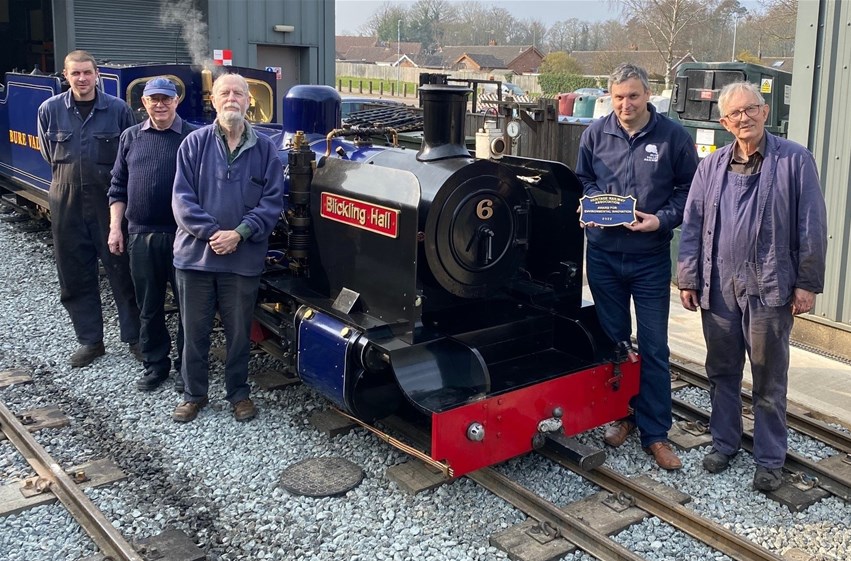Eco Coal Initiatives

The Bure Valley Railway is proud of its ambitious work in taking the lead to find alternative fuels to power the UK’s steam locomotives.
The UK’s locomotives use roughly 26,000 tonnes of coal per year and their operators around the country will soon be forced to import this, with the only remaining UK lump coal mine in Wales scheduled to close in 2022. It's never been more important for the industry to evolve and we’re at the forefront of this innovation.
Becoming sustainable to reduce our carbon footprint and to ensure future generations can enjoy heritage railways is crucial for the Bure Valley Railway.
We’ve teamed up with Advanced Steam Traction Trust (ASTT), Heritage Railway Association (HRA), Network Rail and the fuel manufacturer Coal Products Limited (CPL) to find alternative fuels for the sector. For a few years, we’ve been trialling variants of Ecoal50. This fuel reduces CO2 emissions by 42% compared to standard coal and is made of waste biomass from the olive oil production process, blended with coal dust.
Our work will help lead the way for other heritage railways to switch to more sustainable, environmentally friendly fuels. Currently, products have been developed which would suit half of the railways in the country, with work ongoing to increase the viability of these sustainable substitutes.
Andrew Barnes, our Managing Director, says “Beyond getting something that works for everybody, what we really want is to get a total bio product with very limited coal content. We want to achieve this while maintaining the heritage, character and history of steam railways, and recognising their environmental obligations now and for years to come.”
The work done on the Bure Valley Railway has been trialled on larger standard gauge railways too, with trials and data sharing taking place on the Keighley and Worth Valley Railway in 2022. This tested formula, created by CPL, featured up to 20 per cent biomass and emitted up to 80 per cent less smoke than traditional coal.
Through collaboration and data sharing, it has been possible to develop a low chlorine fuel which is kinder to our locomotive boilers.
The railway has placed collaboration at the centre of its efforts, with a vast array of data collected and shared during these ongoing trials, to continue driving innovation forwards. Andrew adds, “we’re proud of our work and the results we are achieving. We have to change as an industry, so we need the industry to be fully behind our work and to work together with them on a solution.”
Trials of this biomass blended fuel are ongoing alongside the Bure Valley Railway’s continuing work to innovate and improve locomotive efficiency.
Inspired by the tireless work of Formula One teams to push their vehicle’s performance and engineering further, Andrew connected computers to the steam locomotives on the railway and analysed the aspects which degraded their efficiency. In 2022, a project was completed to make the steam ways smoother, improve the blast nozzle and ensure all valve gears are perfectly balanced. Impressively, this saves 30% in coal and water consumption, allows an increase in passenger train miles and saves 79 tonnes of CO2 per year. These innovations have since been rolled out across the railway’s five locomotives. The railway won the Heritage Railway Association Award for Environment Innovation in 2022 for this work, and it was also shortlisted in the Outstanding Visitor Attraction category.
As well as locomotive fuels and mechanical efficiencies, the railway is conscious of its responsibility to the biodiversity and protection of the local area.
We have been working hard to protect the wildlife and habitats alongside our narrow gauge line, including preserving wildflower meadows. We’ve also been improving our environmental impact in our stations at Wroxham and Aylsham, with all lighting now LED and energy-efficient appliances being used in our catering activities.
Andrew says, “60 years ago, the focus was on saving lines and restoring locomotives, but now the industry is more mature and is acknowledging its environmental obligations and environmental responsibilities. Our railway is very well placed to preserve heritage and history, and we are doing it in a way that’s as environmentally friendly and responsible as possible.”
We’re incredibly proud of our fantastic work in innovating heritage railway operations and our commitment to consciously improve our environmental impact. We hope this work will continue to preserve the history and character of the UK’s railways for generations to come.